Plastic waste remains a huge problem amid the pandemic, but makers of fast-moving consumer goods remain stuck in waste retrieval and co-processing measures that barely make an impact.
BY ELYSSA LOPEZ
Philippine Center for Investigative Journalism
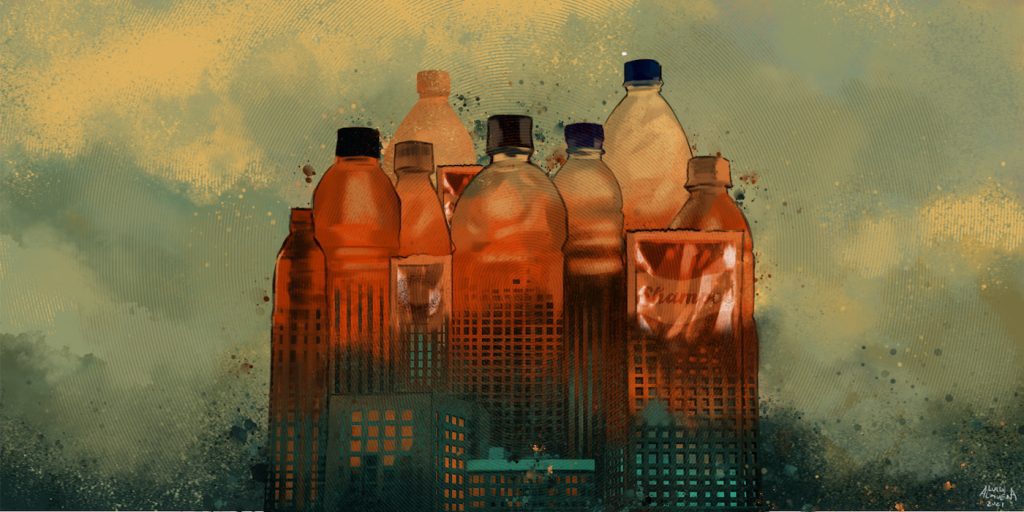
Smol, the 50-something owner of “Smol Mart” in Brgy. Little Baguio in San Juan in the country’s capital, has kept his sari-sari store open despite prolonged lockdowns due to the coronavirus pandemic.
Restaurant workers and residents of the neighborhood have kept his business afloat, as his usual patrons, children from the nearby school, have been forced to stay home and attend online classes.
One would think the lockdowns have led to reduced consumption and therefore less waste. But Smol’s trash bin is always filled with used sachets of 3-in-1 instant coffee from Nescafé, Kopiko, Great Taste, and San Miguel, replacing empty bags of children’s snacks.
Even in online shopping, which saw an exponential rise amid the pandemic, fast-moving consumer goods (FMCGs) continue to experience high demand.
MetroMart, a grocery delivery service launched in 2017, saw its customer base grow 10 times during the pandemic. The company operating the app has since expanded its services to more areas and now delivers to all cities in Metro Manila, parts of Calabarzon, and Cebu City.
Operations director Evreem Al-Shatti Fortich said MetroMart clients shopped at least twice a week through the app. “[The cost] of the basket size [of our clients] range from P4,500 to P5,000,” Fortich said.
In August, the Department of Environment and Natural Resources (DENR) said solid waste collected in Metro Manila alone increased during the pandemic. This was also partly due to the increase in online shopping shipments.
“In 2019, we had about 9,333 tons per day [of] solid waste collected here in the NCR (National Capital Region). But now, in 2021… the collection is about 11,953 tons per day,” Environment Undersecretary Benny Antiporda said in a news conference.
Environmental advocates are calling for drastic measures as the plastic waste problem is only bound to worsen. In every part of its lifecycle, plastics contribute to greenhouse gas emissions, from the extraction of fossil fuels for its production to when it leaks into oceans and releases methane when it breaks down, according to a 2019 report of the Center for International Environmental Law.
It’s already a crisis even prior to the pandemic.
In 2015, the Philippines was named one of the top producers of marine waste in the report titled “Plastic waste inputs from land into the ocean.” The report, written by a group of academics and published in the journal Science, has been cited more than 6,300 times. It estimated that the Philippines had leaked 0.75 million metric tons of plastic into the ocean in 2010 alone. Two years later, a nongovernment organization called Break Free From Plastic* (BFFP) launched a global campaign aiming to identify the brands producing plastic wastes in 42 countries.
The following were identified as the top plastic-polluting corporations in the country from 2018 to 2020: Coca-Cola Beverages Philippines Inc., Colgate-Palmolive Philippines Inc., PT. Mayora Indah Tbk – Kopiko Philippines, Monde Nissin Corp., Mondelez Philippines Inc., Nestlé Philippines Inc., Liwayway Holding Corp., Procter & Gamble Philippines Inc., Unilever Philippines Inc., Universal Robina Corp., JBC Food Corp., Republic Biscuit Corp., WL Foods Inc., San Miguel Corp., and Philippine Spring Water Resources Inc.
These companies, which have figured in the top 10 list of brand and waste audits conducted in the Philippines, have mostly adopted waste retrieval and co-processing to reduce plastic waste. An investigation by the Philippine Center for Investigative Journalism (PCIJ) has found, however, that these “solutions” are temporary and among the least preferred solutions by experts.
Waste retrieval initiatives
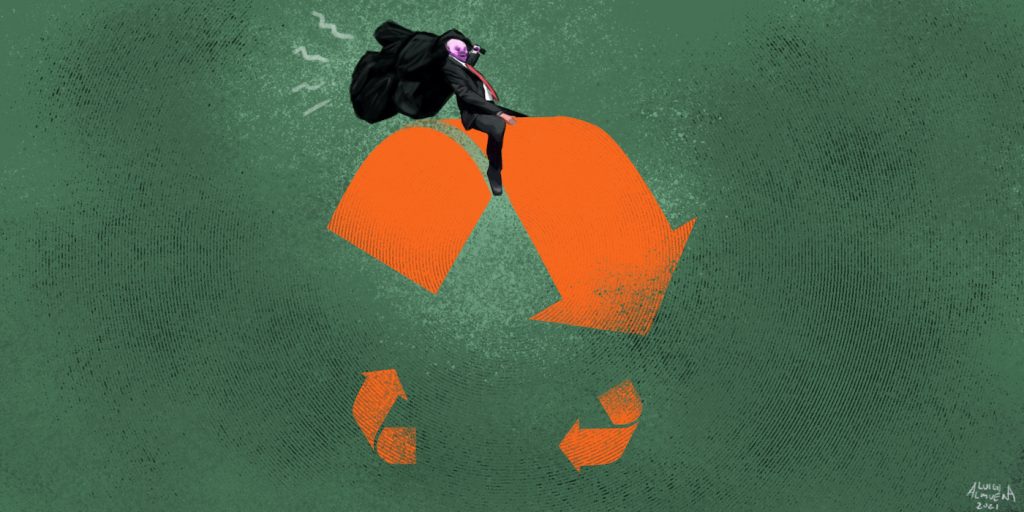
So far, 12 out of the 15 FMCG companies named in the BFFP brand audit have committed to a recycling program.
Most companies have focused on waste retrieval efforts, wherein a third-party partner collects as much of the plastics they had produced for a specific period. The plastic wastes retrieved would then be recycled to other uses, such as construction materials. They may also be sent to cement companies, which feed them into their kilns as alternative fuel.
Eleven of the companies are members of the Philippine Alliance for Recycling and Materials Sustainability (PARMS). The alliance adopted a waste retrieval system that aims to collect at least 20% of the plastic produced by its members by 2023.
“We aim to achieve zero waste to nature, where none of our products would end up in the environment… We will do this through a waste retrieval system that complements the existing waste management programs of local government units,” said PARMS chairman Crispian Lao. He is also the private sector’s representative for recycling at the National Solid Waste Management Commission.
This year, the group released a 64-page report detailing its members’ plastic generation capacities and how they intend to reduce waste and prevent them from leaking into the environment. The report was shared with PCIJ by a representative of Monde Nissin, a PARMS member, after PCIJ asked about the company’s recycling initiatives.
The report estimated that the Philippine FMCG industry yielded 603,000 metric tons (MT) of plastic in 2019, about 150,000 MT shy of the volume estimated to have leaked into the oceans in 2010.
The number was derived from the data provided voluntarily by PARMS members and sales estimates from consumer behavior consulting firm Nielsen IQ. The estimate took into account 47 product categories that can be broadly classified into three: rigid plastics, and high-diversion value (HDV) and low diversion value (LDV) flexible plastics.
Typical uses of rigid plastics include cosmetic and soap bottles and PET beverage bottles. Flexible plastics are mostly used in sachet form.
Before the pandemic struck, PARMS had started collecting plastic wastes in Parañaque, where it has seven partner schools. Each school segregated plastic wastes at the source, making it easier to collect them for processing by recycling companies.
“We designed the project in a way that each school can benefit as they can receive a recycled chair for 30 kilos of plastic for example,” Lao said. “Although some preferred other products, like washing stations.”
The entire project draws from the concept of “plastic neutrality,” which has grown in acceptance as manufacturers find ways to achieve sustainability in their operations. Lao said his team introduced the concept in talks with stakeholders.
In a position paper published in January 2021, the World Wide Fund for Nature (WWF) defined plastic neutrality as the “ability to completely offset a plastic footprint (whether an individual, company, organization, etc.) by directly investing in projects that collect or recycle plastic, or more indirectly by purchasing credits from a third-party organization that is tied to projects which collect from nature and/or drive additional recycling.”
Wastes retrieved by PARMS members are turned over to Green Antz Builders Inc., which processes plastic waste laminates by shredding, cleaning, and drying them before mixing them with sand, cement, gravel, water, and an additive to produce construction materials like eco-bricks and pavers.
The company was founded by a former Nestlé Philippines employee, Rommel Benig, in 2013. In an interview with BusinessWorld, Benig said his connection with the company allowed him to “create demand” for Green Antz. Some facilities of Nestlé Philippines are now partly made of eco-bricks.
That partnership has allowed Green Antz to ink deals with more FMCG companies. Colgate-Palmolive Philippines Inc., for example, has partnered with the company for its Closed Loop Plastic Waste Management Program with five local government units (LGUs) in the province of Bulacan in 2021. The LGUs collect plastic wastes from their respective constituents, which will be retrieved by Green Antz. The wastes will then be used to build handwashing stations for schools.
Another partner, Plastic Credit Exchange (PCEX), is a third-party organization that awards plastic credits to companies that want to achieve plastic neutrality. On its website, PCEX says a portion of plastic wastes it collects for companies like Nestlé Philippines and NutriAsia Inc. are fed to the kilns of cement manufacturers like CEMEX Philippines.
The cement kiln is the heart of the production process of concrete, as it heats limestone into powder. This process needs extreme heat, reaching between 1,400 to 1,500 degrees Celsius. To reach this temperature, cement manufacturers use fuel, usually diesel, to power the kilns.
This is where the plastic wastes from partner companies come into the picture. Alternative fuels such as plastic wastes have been used since the turn of the century to power these kilns.
Plastic wastes are sorted and cleaned up to be burned either on their own or in combination with other wastes like rubber tires to serve as energy sources for cement kilns. This process is called co-incineration, or what some refer to as “co-processing.” Big cement companies like Republic Cement and Holcim Philippines use this process.
Plastic retrieval: Low and slow

Environmentalists however doubt the sustainability of the waste retrieval and treatment efforts of FMCG companies, pointing out that plastic waste retrieval rates remained low.
A 2021 World Bank report found that only 28% of the four key plastic materials in the Philippines, PET4, PP, HDPE and LLDPE/LDPE, were recycled in 2019. PET4 plastics, the key material used in bottled water drinks, were found to have the highest retrieval rate of 48%.
“We’ve only recycled a small fraction of what we have produced. The collection rate depends on the material… If there’s value in the materials then there’s a bigger chance they can be recycled.
But unfortunately, the recycling infrastructure in the Philippines is not that mature [so most items don’t get recycled],” said Miko Aliño, program coordinator of the Asia Pacific office of the Global Alliance for Incinerator Alternatives (GAIA).
In interviews with PCIJ, representatives of two companies that collect plastic waste, Plastic Flamingo and Trash Panda, admitted that their waste retrieval rates remained low and slow.
The collection of wastes is only guaranteed in regions with a high rate of urbanization, according to environmental campaigners.
Only 13,612 out of 42,000 barangay (villages) in the Philippines have materials recovery facilities or MRFs as of 2018.
“Right now, these waste collectors and the current efforts of corporations are beneficial in dealing with the problem. But as the global population increases, naturally more and more people would mean more and more waste,” Gregorio Rafael Bueta, an environmental lawyer, said. “It doesn’t seem like a sustainable solution.”
Bueta said transparency was needed to make private companies’ recycling efforts credible to consumers. “If we are to solve this plastic waste crisis, open, transparent data is very crucial. This can give the general public a good enough, accurate picture of the plastic production of the companies [by which we can hold them accountable],” he said.
Lao was unable to share how much waste PARMS has collected so far, but maintained that wastes sent to partner recycling centers were processed into other products like furniture and construction materials.
In the 2021 report by PARMS, the group also admitted that waste retrieval of LDV flexible plastics, usually in sachet form, was low, as recyclers tended to reject them due to their low quality.
Some companies like Nestlé Philippines have voluntarily pledged plastic neutrality. The company said it collected 27,000 metric tons of plastic waste from August 2020 to July 2021, the same amount of plastic it produced during the same period.
License to pollute?

The WWF is against the use of terms “plastic neutrality” and “plastic neutral.” Efforts to retrieve residual wastes must be treated as “additional” measures in curbing the plastic problem and not the sole solution, it said. Plastic crediting systems, it warned, were being used to continue producing plastics and there is no standard in their accounting practices.
“By simply purchasing plastic credits, companies could make claims such as ‘plastic neutral’ while still polluting from their own supply chain and operating under business-as-usual conditions,” the organization said in its January 2021 position paper.
For example, companies can earn plastic credits by collecting plastic bottles, but continue to produce sachet products.
For its part, Nestlé said “plastic neutrality” was an “intermediate solution,” adding that it was taking a “holistic approach to address the urgent and complex issue of plastic waste.”
“We are taking a holistic approach in tackling plastic waste—from our use of packaging, collection and diversion of waste, to consumer education,” said Anne Michelle Pador, vice president for corporate communications of Nestlé Philippines.
Another issue raised by the WWF is the lack of transparency in how wastes were processed.
Some plastics retrieved by PCEX end up burned as part of cement companies’ co-processing activities, a practice frowned upon by experts.
In 2018, British think tank Chatham House reported that cement production was the third largest source of global carbon dioxide emissions in the world at 8%, following the agricultural industry at 12%.
While the practice is allowed by law in the Philippines, regulation is lax and some experts find the practice unsustainable.
“When your recycling method is achieved by burning, you release carbon dioxide. So, for a cement company, if you are using plastics, for me, you are only reducing fuel costs, since you are no longer solely relying on coal [to operate the cement kiln for clinker production],” said Christian Orozco, a professor at the University of the Philippines College of Civil Engineering.
Under DENR Administrative Order No. 2010-06, companies operating cement kilns must keep records of their operations, which may be checked by authorities when needed. These records are not shared with the public.
“For now, it (co-processing) may be a token scheme… but it can’t accommodate everything [that we need for proper management of plastics],” Aliño said. “Burning plastics also have impacts on human health and the environment.”
Unilever and Nestlé, which had signed partnerships with cement companies, also admitted that co-processing was an “interim” and “intermediate” solution.
“Our partnerships with Cemex and Republic Cement for co-processing plastic waste provides a safe interim solution until a circular recycling alternative becomes available in the future,” Ed Sunico, Unilever vice president for communication for Southeast Asia, said in an email to PCIJ.
Orozco, who had studied cement production in the country, said the environmental benefits of co-processing had yet to be extensively researched. Still, he contended that the operation of kilns in cement production was one of the biggest contributors to the carbon emissions of cement companies, reaching as high as 80%.
In the hierarchy of solid waste management strategies under the Basel Convention on the Control of Transboundary Movements of Hazardous Wastes, an international treaty, treating wastes for energy recovery is the second to the last favorable option, next only to total disposal. Prevention and minimization of wastes are the top two options.
This hierarchy of waste management options was adopted by the Philippines’s Republic Act (RA) 9003 or the Ecological Solid Waste Management Act passed in 2001.
Aliño and Bueta said that instead of plastic neutrality, companies should adopt the “circular economy concept,” defined by the UK-based Ellen Macarthur Foundation as based on the principles of “designing out waste and pollution, keeping products and materials in use, and regenerating natural systems.”
Under this scheme, what is produced must be returned to the producer so the item may be reused again. It mimics the process of the natural world where living things end up as another key material in the creation of new living things once they reach the end of their lives.
The existing production system follows a linear approach, where products are made then disposed of. When items are recycled, they are only downgraded to other uses, but still end up as waste.
“We keep downcycling the plastics but the end product still ends up in landfills. We just degrade the quality of the plastic. That is not sustainable since we’re still going to bulk up waste,” Aliño said.
Orozco said there were also no extensive studies on the durability and longevity of plastics processed into or added as a material in the production of construction materials.
“We need to ask: When the infrastructure made out of these materials reaches their end of life, are we going to melt them again to be used for other uses? How do we dispose of them?” he said.
GAIA’s Aliño mentioned Coca-Cola as an example of a company pursuing a circular production.
The beverage giant is set to launch the Philippines’s first food-grade bottle-to-bottle recycling facility by 2022. This means retrieved plastics, like used PET beverage bottles, will be processed into PET bottles again. The company has also committed to make 100% of its packaging recyclable by 2025.
However, Aliño said he would have preferred Coca-Cola to go back to using glass bottles as its primary distribution system, and reintroduce its deposit-return system. “Things started to go downhill when Coca-Cola switched to PET bottles. The recycling facility can help process used PETs, but would still need virgin plastic materials to produce rPET (recycled PET). Moreover, PET bottles have some value in scrap markets that encourage recovery, it’s not the case in rural or island settings where recovery is more expensive because of transportation costs and low volume of recyclable plastics,” he said.
No urgency
While experts commend corporations’ proactive approach to curbing the waste problem, more should be done to solve the plastic crisis, they said.
For Bueta, the plastic problem would require a “whole-of-society” approach.
“I think a good question to ask now is: Why are we not acting as urgent about this plastic crisis as the health crisis that we have now? Even when we already know the waste crisis can affect our lives. Why are we not doing enough? That [question] is for all of us [consumers, manufacturers, and the government],” Bueta said.
Proper implementation of waste management laws is also needed, experts said.
RA 9003 was expected to implement an exhaustive and comprehensive plan for the proper management of wastes in the country with the National Solid Waste Management Commission (NSWMC) as the main facilitator. The law requires:
• the establishment of a materials recovery facility in every town and city;
• a total ban on incineration;
• closure of illegal dumpsites; and
• a market plan for the recycling of plastic wastes.
The law is routinely violated. RA 9003 requires wastes to be segregated at source, starting from households and establishments. Avoidance, reduction, reuse, and recycling of wastes are preferred over treatment and disposal.
This provision is not followed in most households, the source of 57% of waste, according to a study by the Philippine Institute for Development Studies (PIDS), the state think tank.
In a discussion paper titled “An Analysis of Regulatory Policies on Solid Waste Management in the Philippines: Ways Forward,” the PIDS said the law’s main facilitator, NSWMC, had failed to properly delegate to LGUs their critical role in the implementation of RA 9003.
“The overly simplistic transfer of responsibility [of solid waste management implementation] to local government units, even just to complement the local government code, have resulted [in] two decades of mediocre policy grounding,” the paper noted.
PIDS found the waste management strategies in four LGUs to be “far from ideal.”
“Although commendable islands of successes were seen in the case study sites, no ideal holistic solid waste management set-ups were manifested: illegal dumpsites still exist, waste generation is still unabated, material recovery is suboptimal, technology and facility investment is subpar, and public and private participation are wanting,” PIDS said.
Single-use plastics
Even as waste management practices remain far from ideal, lawmakers are not so keen on eradicating the source of much waste altogether.
A total of 388 bills and resolutions addressing solid waste or phasing out single-use plastics have been filed in Congress since 2010, but not one made it to the priority list.
House Bill (HB) 9147, which consolidates 41 other bills and resolutions previously filed in the chamber, was approved on third and final reading in July 2021, the farthest stage reached by such a measure. The bill has yet to be tackled by the Senate.
The measure aims to phase out single-use plastics like drinking straws and low-quality plastic bags within a year after the measure becomes law.
It also proposes that producers and importers “recover or off-set and divert into value chains” at least 50% of their single-use plastic product footprint within three years of the law’s effectivity.
HB 9147 adopts the policy on Extended Producers’ Responsibility (EPR) of the Organization for Economic Cooperation and Development (OECD), in which producers are given a significant responsibility – financial and/or physical – for the treatment or disposal of post-consumer products. The concept was first introduced by academic Thomas Lindhqvist in 1990 to the Swedish environmental ministry.
The EPR however will only work with cooperation from the private sector. A recovery scheme will only be successful if private companies are willing to declare the volume of plastics they are producing, according to environmental campaigners.
Most members of PARMS aren’t keen to do that for now, said Lao.
“We are supportive of EPR, on the condition that the targets are achievable. We have to be grounded with [our goals]. We are an archipelagic country… if you set an ambitious target as early as now, the [current] infrastructure will not be able to catch up,” he explained.
While a national legislation on single-use plastics is pending, local governments are taking charge. At least 500 cities and municipalities in the Philippines have passed ordinances banning single-use plastics, according to Greenpeace.
Bacolod City has prohibited business establishments from using plastic bags since 2011. In November 2018, the city government added plastic straws and stirrers to the list of prohibited single-use plastics. Only plastic packaging without handles for the storage of fresh food like meats and vegetables is allowed.
Also in 2018, Baler town in Aurora banned “non-biodegradable” plastics and cellophanes for packaging goods. But plastic bags declared “oxo-biodegradable,” or manufactured with more synthetic materials that break down easily when disposed of, may still be used for packaging fresh food.
Quezon City, the country’s largest in terms of population, passed two ordinances in 2019, banning plastic bags in retail stores and disposable utensils in food and hotel establishments, including paper or plastic cups, plates, straws, and styrofoam.
Hotels are also prohibited from distributing soap and shampoo sachets to guests, while food establishments may no longer offer ketchup or soy sauce packets and condiment cups with lids.
Radical changes needed
Stakeholders are calling for admittedly radical but necessary interventions to solve the plastic waste crisis.
Plastic Flamingo, also known as the Plaf, a social enterprise that collects plastic wastes from partners like schools and villages and sends them to recycling centers, has collected 110,000 tons of plastic, after setting up 140 recycling drop-off points since it launched in 2018. It believes its role should be temporary.
“I think our mission should be where we don’t need to exist because, in the end, we don’t want any plastics recycled because we want to find proper alternatives to it… But in the meantime, as we have created a big backlog of plastics created anyway, [so] we deal with it,” Anne-Sophie Zwarteveen-van der Spek, chief product officer of Plastic Flamingo, said.
Bueta said manufacturers should invest in technologies to redesign their packaging and help them achieve EPR standards. This may also mean banning the use of plastic sachets for packaging.
There was no mention of any plastics ban in the 2021 PARMS report, but it said members might be able to reduce their LDV packaging materials to as much as 21% of their 2019 estimates, “in a fully implemented strategy scenario.”
Bueta, the environmental lawyer, said “companies would have to allow change.”
“They need to refocus their goals and reduce their desire for profit. Think they will have to invest millions of pesos to shift their production patterns,” he said.
Not all plastics needed to be eradicated, said Aliño of GAIA. “But single-use plastics that we can do without should be totally banned,” he said. END
This report was produced with the support of Greenpeace Southeast Asia-Philippines. The Philippine Center for Investigative Journalism had full editorial independence. Greenpeace Southeast Asia-Philippines, their officers, and employees accept no liability for any loss, damage, or expense arising out of, or in connection with, any reliance on any omissions or inaccuracies in the material contained in the report.
*BFFP is a global movement. Greenpeace Philippines is an associate member.


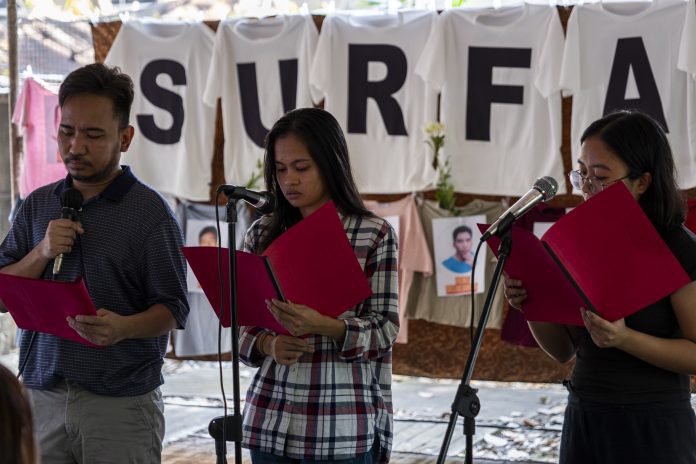
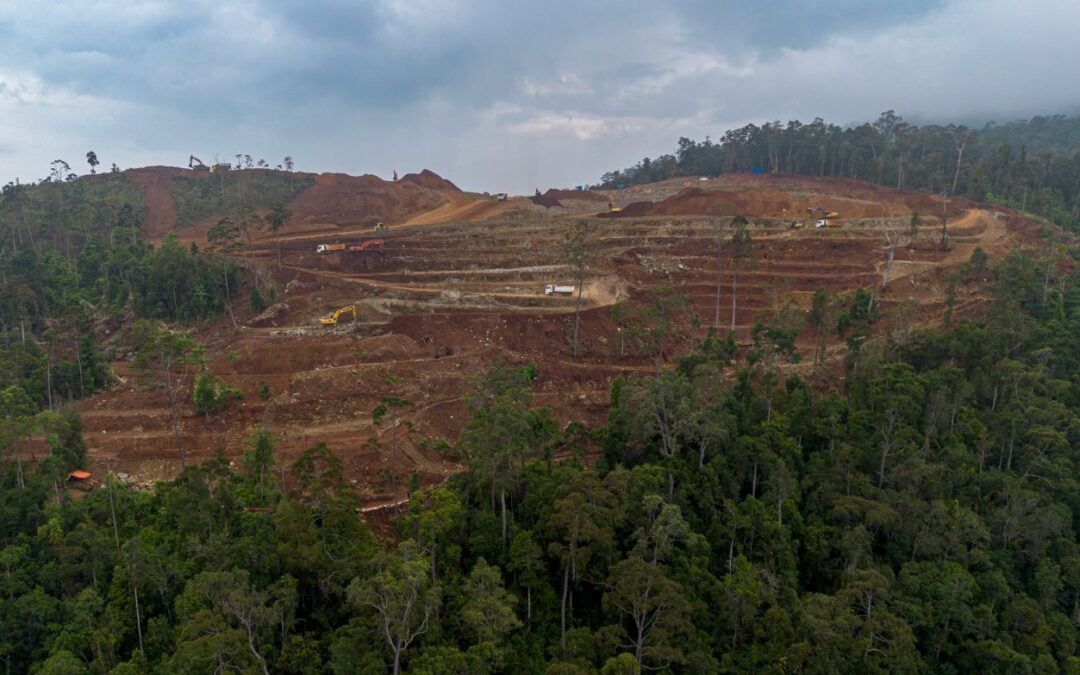
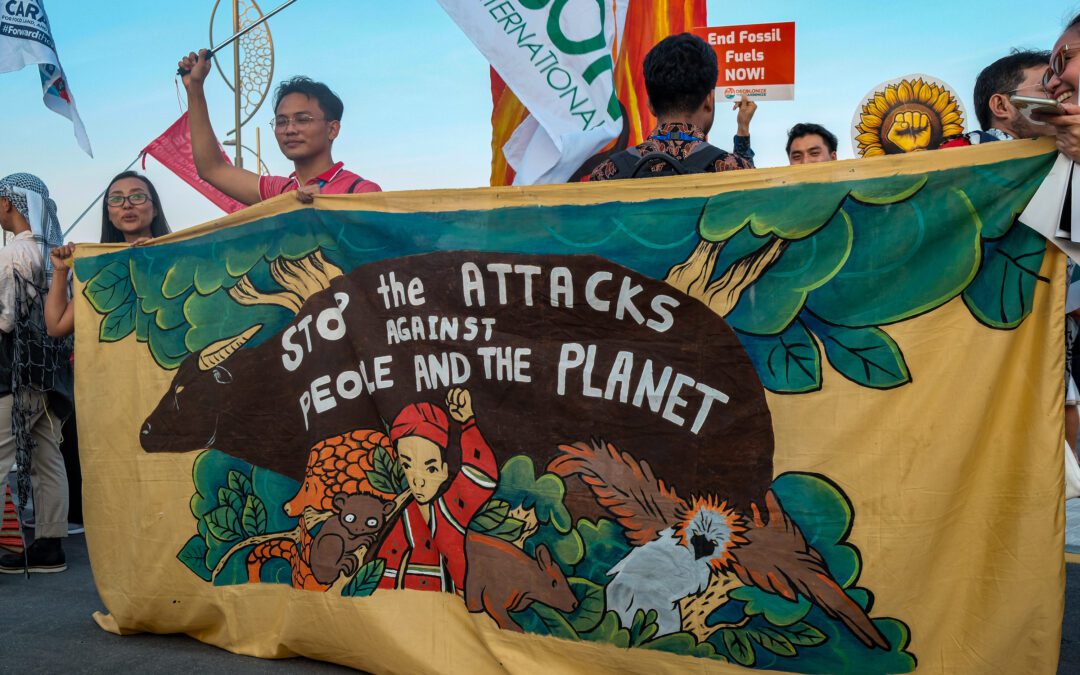

0 Comments